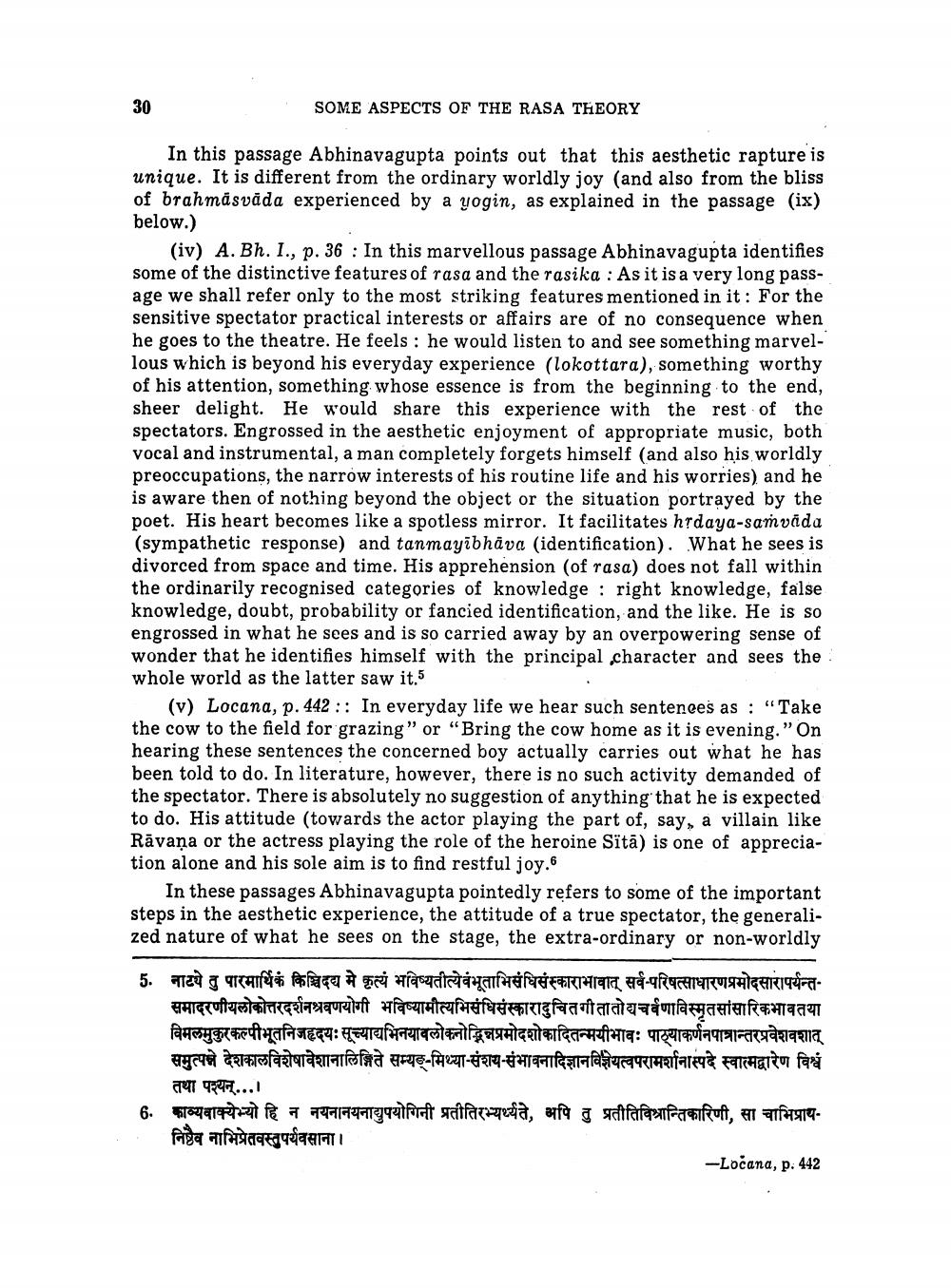________________
SOME ASPECTS OF THE RASA THEORY
In this passage Abhinavagupta points out that this aesthetic rapture is unique. It is different from the ordinary worldly joy (and also from the bliss of brahmäsväda experienced by a yogin, as explained in the passage (ix) below.)
(iv) A. Bh. I., p. 36 : In this marvellous passage Abhinavagupta identifies some of the distinctive features of rasa and the rasika : As it is a very long passage we shall refer only to the most striking features mentioned in it: For the sensitive spectator practical interests or affairs are of no consequence when he goes to the theatre. He feels: he would listen to and see something marvellous which is beyond his everyday experience (lokottara), something worthy of his attention, something whose essence is from the beginning to the end, sheer delight. He would share this experience with the rest of the spectators. Engrossed in the aesthetic enjoyment of appropriate music, both vocal and instrumental, a man completely forgets himself (and also his worldly preoccupations, the narrow interests of his routine life and his worries) and he is aware then of nothing beyond the object or the situation portrayed by the poet. His heart becomes like a spotless mirror. It facilitates hrdaya-samvada (sympathetic response) and tanmayibhāva (identification). What he sees is divorced from space and time. His apprehension (of rasa) does not fall within the ordinarily recognised categories of knowledge : right knowledge, false knowledge, doubt, probability or fancied identification, and the like. He is so engrossed in what he sees and is so carried away by an overpowering sense of wonder that he identifies himself with the principal character and sees the whole world as the latter saw it.5
(v) Locana, p. 442 :: In everyday life we hear such sentences as : "Take the cow to the field for grazing" or "Bring the cow home as it is evening.” On hearing these sentences the concerned boy actually carries out what he has been told to do. In literature, however, there is no such activity demanded of the spectator. There is absolutely no suggestion of anything that he is expected to do. His attitude towards the actor playing the part of, say, a villain like Rāvana or the actress playing the role of the heroine Sïtā) is one of appreciation alone and his sole aim is to find restful joy..
In these passages Abhinavagupta pointedly refers to some of the important steps in the aesthetic experience, the attitude of a true spectator, the generalized nature of what he sees on the stage, the extra-ordinary or non-worldly
5. नाटये तु पारमार्थिक किञ्चिदद्य मे कृत्यं भविष्यतीत्येवंभूताभिसंघिसंस्काराभावात् सर्व-परिषत्साधारणप्रमोदसारापर्यन्त
समादरणीयलोकोत्तरदर्शनश्रवणयोगी भविष्यामौत्यभिसंधिसंस्कारादुचितगीतातोद्यचर्वणाविस्मृतसांसारिकभावतया विमलमुकुरकल्पीभूतनिजहृदयः सूच्याद्यभिनयावलोकनोद्भिन्नप्रमोदशोकादितन्मयीभावः पाठ्याकर्णनपात्रान्तरप्रवेशवशात् समुत्पन्ने देशकालविशेषावेशानालिङ्गिते सम्यङ्-मिथ्या-संशय-संभावनादिज्ञानविज्ञेयत्वपरामर्शानास्पदे स्वात्मद्वारेण विश्वं
au 947... 6. काव्यवाक्येभ्यो हि न नयनानयनाद्युपयोगिनी प्रतीतिरभ्यर्थ्यते, अपि तु प्रतीतिविश्रान्तिकारिणी, सा चाभिप्रायनिष्ठैव नाभिप्रेतवस्तुपर्यवसाना।
-Ločana, p. 442




